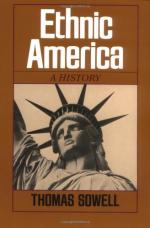
|
| Name: _________________________ | Period: ___________________ |
This test consists of 15 multiple choice questions and 5 short answer questions.
Multiple Choice Questions
1. Why did lighter skin become overrepresented among achieving blacks?
(a) Lighter skin is better looking.
(b) Lighter skin leads to greater ambition.
(c) Free persons of color had more white ancestors.
(d) Lighter skin means higher intelligence.
2. In California, Japanese immigrants initiated what two business models?
(a) Contract gardening and produce markets.
(b) Restaurants and dance academies.
(c) Language schools and bakeries.
(d) Market gardens and ornamental horticulture.
3. What type of immigrant group is most likely to retain a foreign language and culture?
(a) Those with back-and-forth migration.
(b) Those whose culture is not represented in the U.S.
(c) Those who are mistreated by mainstream governmental agencies.
(d) Those who are discriminated against.
4. Why are the Hong Kong youth gangs a threat to Chinatowns?
(a) They cause property destruction.
(b) They intimidate business owners.
(c) They frighten away tourists.
(d) They cause loss of life.
5. What was a "picture bride"?
(a) A bride from Japan accepted on the basis of a photograph.
(b) A perfectly beautiful bride.
(c) A bride from the U.S. accepted on the basis of a photograph.
(d) A bride who spoke no English.
6. Many Japanese immigrants were successful entrepreneurs because of their ability to _________________.
(a) Foreseen trends.
(b) Share profits.
(c) Accept risk.
(d) Calculate costs.
7. What did the Supreme Court's Dred Scott decision declare that blacks did not have?
(a) Any rights at all.
(b) The right to be respected.
(c) Rights white men had to respect.
(d) Rights other blacks had to respect.
8. On what basis were Japanese immigrants to the U.S. preselected by the Japanese government?
(a) Health, character and willingness to work.
(b) Criminal tendencies.
(c) Desire for adventure.
(d) Tired and poor.
9. During the Civil War, what percentage of Union troops were black?
(a) 2%.
(b) 5%.
(c) 50%.
(d) 10%.
10. What mode of travel was first predominantly used in the Puerto Rican migration to the U.S.?
(a) Steamships.
(b) Air.
(c) Rail.
(d) Sailing ships.
11. Why are the Hong Kong Chinese vulnerable to employer exploitation?
(a) Many are in the U.S. illegally.
(b) Many do not have job skills.
(c) Many do not understand U.S. customs.
(d) Many are engaged in criminal activity.
12. How were Japanese immigrants treated initially?
(a) They were rejected.
(b) They were welcomed.
(c) They were tolerated.
(d) They were hated.
13. What was a Californio?
(a) A wealthy California Hispanic of the 19th century.
(b) A California stagecoach robber.
(c) A wealthy California Hispanic of the 20th century.
(d) An enslaved California Hispanic of the 19th century.
14. Why have the Chinese been called "the Jews of Asia?"
(a) Their success in business has been resented.
(b) They have been universally excluded.
(c) They have been universally welcomed.
(d) Their success in business has been applauded.
15. How many languages were and are spoken in Africa?
(a) Around 200.
(b) Over 1,000.
(c) More than 800.
(d) Fewer than 500.
Short Answer Questions
1. How does the Chinese America crime rate compare to other immigrant groups?
2. In New York, what percentage of Chinese residents accepted federal aid during the Great Depression?
3. What "pushed" Mexicans to leave Mexico in the early 20th century?
4. What was a "hatchet man"?
5. How did many of the Japanese regard the United States during the 19th century?
|
This section contains 543 words (approx. 2 pages at 300 words per page) |

|




